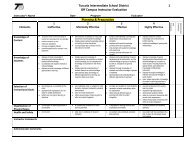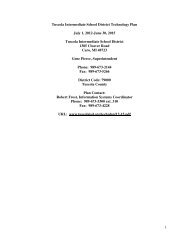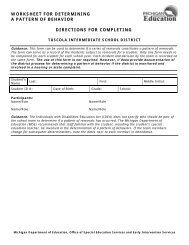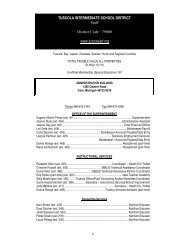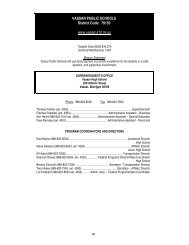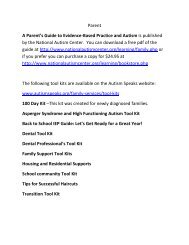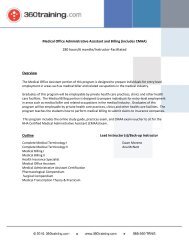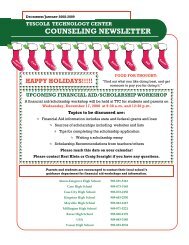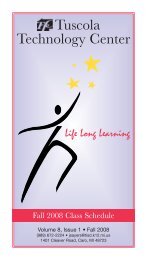S. SECLUSION & RESTRAINTSSUPPORTING STUDENT BEHAVIOR:STANDARDS FOR THE EMERGENCY USE OF SECLUSION AND RESTRAINTSeclusion is a last resort emergency safety intervention that provides an opportunity for a student toregain self-control. Seclusion is the confinement of a student in a room or other space from which thestudent is physically prevented from leaving and which provides for continuous adult observation of thestudent. A room or area used for seclusion:Must not be locked;Must not prevent the student from exiting the area should staff become incapacitated or leavethat area; andMust provide for adequate space, lighting, ventilation, viewing, and the safety of the student.Time and Duration – Emergency seclusion (prohibited for pre-school students) should not be used anylonger than necessary to allow a student to regain control of his/her behavior, but generally:Elementary school students – no longer than 15 minutes; andMiddle and high school students – no longer than 20 minutes.If an emergency seclusion lasts longer than the suggested maximum time, the following arerequired:o Additional support (e.g., change of staff, introducing a nurse or specialist, obtainingadditional expertise); ando Documentation to explain the extension beyond the time limit.Physical Restraint is a last resort emergency safety intervention involving direct physical contact thatprevents or significantly restricts a student’s movement. Restraint is an opportunity for thestudent to regain self-control. Physical restraint is not intended to forbid actions undertaken:to break up a fightto take a weapon away from a studentthe brief holding by an adult in order to calm or comfortthe minimum contact necessary to physically escort a student from one area to anotherassisting a student in completing a task/response if the student does not resist or resistance isminimal in intensity or duration.To hold a student for a brief time in order to prevent an impulsive behavior that threatens thestudent’s immediate safety (e.g., running in front of a car)Time and Duration – Restraint should not be used:Any longer than necessary to allow students to regain control of their behavior; andGenerally no longer than ten minutesIf an emergency restraint lasts longer than ten minutes, the following are required:o Additional support (e.g., change of staff, introducing a nurse or specialist, obtainingadditional expertise); ando Documentation to explain the extension beyond the time limitReoccurring Behavior – Should a pattern of behavior emerge, or be anticipated, which may require theuse of emergency restraint, the school personnel must:Conduct a functional behavioral assessment;Develop or revise a PBSP to facilitate the reduction or elimination of the use of restraint;Develop an assessment and planning process conducted by a team knowledgeable about thestudent, including:o The parento The student (if appropriate)o People who are responsible for implementation of the PBSPo People who are knowledgeable in PBS.12
Documentation and Reporting – Each use of an emergency seclusion and the reason for each use shallbe:Documented in writing and reported to the building administration immediately;Reported to the parent or guardian immediately or as soon as possible; andDocumented in a written report for each use of seclusion (including multiple uses within a givenday) and given to the parent or guardian within 24 hours.Once again, seclusion and/or physical restraints are always used ONLY AS A LAST RESORT. Ifseclusion and/or restraint are used frequently, additional documentation will be required. An EIP(Emergency Intervention Plan) will be developed by the student’s behavioral team.T. ANTI-BULLYING/HARRASSMENTThe <strong>Tuscola</strong> <strong>Intermediate</strong> <strong>School</strong> District Board of Education prohibits acts of harassment or bullying.The Board of Education has determined that a safe and civil environment in schools is necessary forstudents to learn and achieve high academic standards. Harassment or bullying, like other disruptive orviolent behaviors, is conduct that disrupts both a student’s ability to learn and a schools’ ability toeducate its students in a safe environment. Demonstration of appropriate behavior, treating others withcivility and respect, and refusing to tolerate harassment or bullying is expected of administrators, faculty,staff, and volunteers to provided positive examples for student behavior. The <strong>Tuscola</strong> <strong>Intermediate</strong><strong>School</strong> District Board of Education expects students to conduct themselves in a manner in keeping withtheir levels of development, maturity, and demonstrated capabilities with a proper regard for the rightsand welfare of other students, school staff, volunteers, and contractors.We consider bullying and harassment as a student delivers disrespectful messages (verbal or gestural) toanother person that includes threats and intimidation, obscene gestures, pictures, or written notes.Disrespectful messages include negative comments based on race, religion, gender, age, and/or nationorigin; sustained or intense verbal attacks based on ethnic origin, disabilities or other personal matters.III.STUDENT CONDUCTA. GENERAL RULES FOR BEHAVIOR & SAFETYParents are to make certain their child is knowledgeable and informed of the following schoolrules:Profane or obscene language/gestures are not allowed.<strong>Student</strong>s are to be courteous to others and respect all school personnel.Running is not allowed in areas other than the gym and playground.Fighting, pushing, and screaming are not allowed.Any items that may be hazardous to the safety of others are not allowed in school and are to beturned into the Principal’s office immediately. Chains and keys are not allowed.Anything not needed for class should be left home. Toys should not be brought unless the teachergives his/her permission for them to be brought to his/her class. <strong>Student</strong>s age 13 and older maybring remote control cars, toys, with permission of the teacher.Electronic communication devices (pagers, cell phones, walkie talkies) are not to be used duringregular school hours (Exceptions may be made by the teacher).<strong>School</strong> personnel try to prevent losses, but they are not responsible for any students’ property (lost,stolen, or broken toys.) Large amounts of money or valuables should not be brought to school.(Headphones, walk-mans, CD players, etc. can be used on the bus only (with approval from busdriver). With special permission if a student brings in a DVD player, the movie MUST be a “G”rated movie.<strong>Student</strong>s will be responsible for breakage, theft, and destruction of others’ personal properties,within reasonable limits.13



